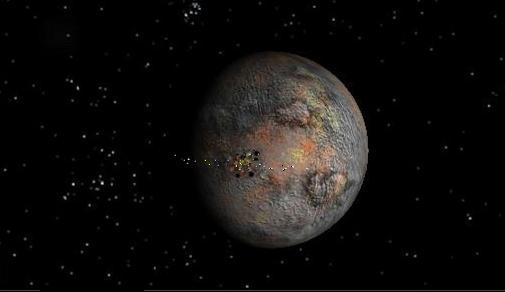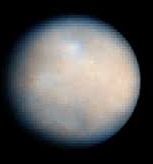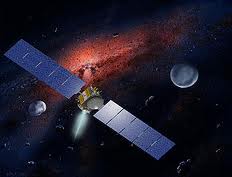

On our journey to learn more about the dwarf planets, the first one we come across is Ceres.

Named after the Roman goddess of agriculture and fertility, Ceres is by far the closest dwarf planet to Earth for it is the only such object located within the main asteroid belt between Mars and Jupiter; technically, Ceres inhabits the inner solar system. This object composed of rock and ice is about 950 km (590 mi) in diameter and consists of about a third of the mass found in the asteroid belt. The dwarf has a semi-major axis of 2.8 Astronomical Units (AU) and an orbital period of about 4.6 Earth years.
Before Ceres was discovered, astronomers were curious about the apparent gap seen between Mars and Jupiter. At the time, there was a hypothesis known as the Titus-Bode law, which basically noticed a pattern seen in the semi-major axes of the then-known seven planets. The hypothesis had recently gotten support because William Herschel discovered Uranus in 1781 near the predicted distance past Saturn. The hypothesis also predicted the existence of a planet between Mars and Jupiter located around 2.8 AU from the sun.

In 1801, Giuseppe Piazzi found Ceres more or less on accident. When he published his findings, he said Ceres looked like a comet but the object could be something more significant. Shortly after Ceres was confirmed, it was designated as a planet, along with other objects such as 2 Pallas, 3 Juno, and 4 Vesta; they held on to the planetary designation for about half a century, even as more and more objects were found orbiting in this same region. Ceres and it’s planetary palls were eventually reclassified as asteroids (just think, people feel like Pluto feels cheated – I’d hate to be in the Ceres camp).
As an interesting side note, in 1802, several astronomers were realizing that Ceres might be the first in a new class of objects. Herschel coined the term “asteroid” meaning “star-like” because he claimed “they resemble small stars so much as hardly to be distinguished from them, even by very good telescopes.” Because Ceres is the first such object to have been discovered, it was designated as 1 Ceres according to the modern system of asteroid numbering.
In the 2006 debate that eventually lead to a definition of ‘planet’, Ceres was back on the table. Ceres fulfills the first two definitions of planet since it’s circular and orbits the sun, but falls dismally short in the category of clearing its orbit – since it shares its orbit with thousands of asteroids. Thus, Ceres was reclassified again, this time, as a dwarf planet.

At the moment, no spacecraft has visited a dwarf planet, but all of that is about to change. The Dawn spacecraft, launched in 2007 by NASA, is on a mission in the asteroid belt. It recently finished a visit on Vesta and is currently headed to Ceres. Dawn is due to arrive at Ceres on February 1, 2015. This means Dawn will be the first spacecraft to visit a dwarf planet, only five months before the New Horizon’s mission reaches Pluto.